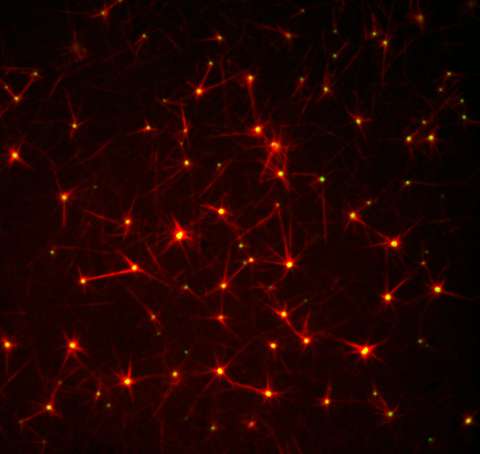The cell copying machine: How daughters look like their mothers

Tiny structures in our cells, called centrioles, control both cell division and motility. The number of these structures is highly monitored, with deviations causing infertility, microcephaly and accelerating cancer. But how do mother cells know they provide the right number of centrioles to their daughters? They do it by copying those structures only once, so that each daughter inherits one of the copies. A research team, from Instituto Gulbenkian de Ciencia (IGC; Portugal), led by Monica Bettencourt-Dias uncovered the mechanism by which the mother copies only once before it distributes it to the two daughters. This study is now published in the latest issue of the scientific journal Current Biology.
When a mother cell divides in two daughters, its structures need to duplicate, so that each daughter cell gets the right complement and looks like its mother. While much is known about the regulation of the duplication of the genetic material, it was a mystery how centrioles are copied only once. Bettencourt Dias' team tackled this question by focusing on the key molecular trigger of centriole formation, a protein called PLK4, which they identified recently. "We found that the trigger only works just before centrioles are made. Something in the cell was inhibiting the trigger at other time points, ensuring the right copy number of centrioles was formed at the right time", says Zitouni Sihem, co-first author of this study.
The research team, in collaboration with scientists from Germany, USA, Japan and France, set out to investigate what was inhibiting this trigger protein at other time points. "We discovered that a key protein complex that sets the cell division clock, CDK1, inhibits PLK4 activity by kidnapping its partner (STIL). In consequence, PLK4 can only start forming centrioles at a particular time of the cell cycle, when CDK1 is not there", explains Zitouni Sihem. The centriole formation machinery is thus regulated by the cell cycle clock, ensuring daughters look like their mothers.
Mónica Bettencourt-Dias adds: "I am very proud of this paper, we knew the cell cycle clock and centriole formation had to be linked- otherwise how would cells ensure the right copy number is made? This is the first link showing how the cell cycle machinery regulates the trigger of centriole biogenesis, ensuring the right number of centrioles is formed at the right time, which is critical for homeostasis."
More information: Zitouni, S., Francia, M. E., Leal, F., Gouveia, S. M., Nabais, C., Duarte, P., Gilberto, S., Brito, D., Moyer, T., Kandels-Lewis, S., Ohta, M., Kitagawa, D., Holland, A. J., Karsenti, E., Lorca, T., Lince-Faria, M., Bettencourt-Dias, M. (2016) CDK1 prevents unscheduled PLK4-STIL complex 1 assembly in centriole biogenesis. Current Biology. DOI: 10.1016/j.cub.2016.03.055.
Journal information: Current Biology
Provided by Instituto Gulbenkian de Ciencia





















